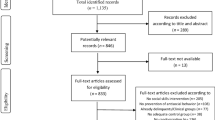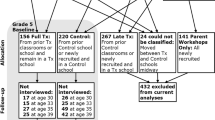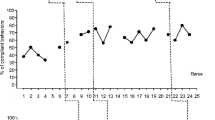Abstract
Objectives
To assess the monetary benefits and costs of the Stop Now And Plan-Under 12 Outreach Project (SNAP-ORP), a cognitive–behavioral skills training and self-control program, in preventing later offending by boys.
Methods
We assess the effect size of the SNAP-ORP program and convert this into a percentage reduction in convictions. We apply this reduction to the number and types of offenses committed by a sample of 376 boys between ages 12 and 20, taking account of co-offending, to estimate the crimes saved by the program. Based on the cost of each type of crime, we estimate the cost savings per boy and compare this with the cost of the SNAP-ORP program for low, moderate and high risk boys. We also scale up from convictions to undetected crimes.
Results
Based on convictions, we estimate that between $2.05 and $3.75 are saved for every $1 spent on the program. Scaling up to undetected offenses, between $17.33 and $31.77 are saved for every $1 spent on the program. The benefit-to-cost ratio was greatest for the low risk boys and smallest for the high-risk boys. However, there were indications that the program was particularly effective for high risk boys who received intensive treatment.
Conclusions
Our benefit-to-cost ratios are underestimates. On any reasonable assumptions, the monetary benefits of the SNAP-ORP program greatly exceed its monetary costs. It is desirable to invest in early prevention programs such as SNAP-ORP to reduce crime and save money.
Similar content being viewed by others
References
Achenbach TM (1991) Manual for the child behavior checklist and 1991 profile. Department of Psychiatry, University of Vermont, Burlington
American Psychological Association (2005) Report of the 2005 presidential task force on evidence-based practice, Washington, DC
Andrews DA, Bonta JL (2010) The psychology of criminal conduct, 5th edn. Matthew Bender & Company, New Providence
Andrews DA, Dowden C (2006) Risk principle of case classification in correctional treatment: a meta-analytic investigation. Int J Offender Ther Comp Criminol 50:88–100
Augimeri LK, Koegl CJ, Webster CD, Levene KS (2001) Early assessment risk list for boys (EARL-20B): version 2. Child Development Institute, Toronto
Augimeri LK, Farrington DP, Koegl CJ, Day DM (2007) The SNAP Under 12 Outreach Project: effects of a community based program for children with conduct problems. J Child Fam Stud 16:799–807
Augimeri LK, Enebrink P, Walsh M, Jiang D (2010) Gender-specific childhood risk assessment tools: early assessment risk lists for boys (EARL-20B) and Girls (EARL-21G). In: Otto RK, Douglas KS (eds) Handbook of violence risk assessment tools. Routledge, New York, pp 43–62
Augimeri LK, Walsh MM, Liddon AD, Dassinger CR (2011a) From risk identification to risk management: a comprehensive strategy for young children engaged in antisocial behavior. In: Springer DW, Roberts A (eds) Juvenile justice and delinquency. Jones & Bartlett, Sudbury, pp 117–140
Augimeri LK, Walsh M, Slater N (2011b) Rolling out SNAP, an evidence-based intervention: a summary of implementation, evaluation and research. Int J Child Fam Stud 2:330–352
Berrueta-Clement JR, Schweinhart LJ, Barnett WS, Epstein AS, Weikart DP (1984) Changed lives: the effects of the Perry Preschool Program on youths through age 19. High/Scope Press, Ypsilanti
Blumstein A, Cohen J (1979) Estimation of individual crime rates from arrest records. J Crim Law Criminol 70:561–585
Blumstein A, Cohen J, Roth JA, Visher CA (eds) (1986) Criminal careers and ‘‘career criminals”, vol 1. National Academy Press, Washington, DC
Boisjoli R, Vitaro F, Lacourse E, Barker ED, Tremblay RE (2007) Impact and clinical significance of a preventive intervention for disruptive boys: 15-year follow-up. Br J Psychiatry 191:415–419
Brand S, Price R (2000) The economic and social costs of crime (Research Study no. 217). Home Office, London, UK
Burke JD, Loeber R (2014) The effectiveness of the Stop Now And Plan (SNAP) Program for boys at risk for violence and delinquency. Prev Sci. doi:10.1007/s11121-014-0490-2
Carrington PJ (2009) Co-offending and the development of the delinquent career. Criminology 47:1295–1329
Carrington PJ (2014) The structure of age homophily in co-offending groups. J Contemp Crim Just. doi:10.1177/1043986214553376
Chaiken J, Chaiken M (1982) Varieties of criminal behavior (Rand report R-2814-NIJ). Rand Corporation, Santa Monica
Cohen J (1986) Appendix B: research on criminal careers: Individual frequency rates and offense seriousness. In: Blumstein A, Cohen J, Roth JA, Visher CA (eds) Criminal careers and ‘‘career criminals”, vol 1. National Academy Press, Washington, DC, pp 292–418
Cohen MA (1988) Pain, suffering and jury awards: a study of the cost of crime to victims. Law Soc Rev 22:538–555
Cohen MA (1998) The monetary value of saving a high risk youth. J Quant Criminol 14:5–33
Cohen MA (2005) The costs of crime and justice. Routledge, New York
Cohen MA, Piquero AR (2009) New evidence on the monetary value of saving a high risk youth. J Quant Criminol 25:25–49
Cohen MA, Rust RT, Steen S, Tidd ST (2004) Willingness-to-pay for crime control programs. Criminology 42:89–110
Cohen MA, Rust RT, Steen S (2006) Prevention, crime control or cash? public preferences towards criminal justice spending priorities. Justice Q 23:317–335
Cohen MA, Piquero AR, Jennings WG (2010a) Monetary costs of gender and ethnicity disaggregated group-based offending. Am J Crim Justice 35:159–172
Cohen MA, Piquero AR, Jennings WG (2010b) Studying the costs of crime across offender trajectories. Criminol Public Policy 9:279–305
Conduct Problems Prevention Research Group (2010) Fast Track intervention effects on youth arrests and delinquency. J Exp Criminol 6:131–157
Cullen FT, Vose BA, Jonson CNL, Unnever JD (2007) Public support for early intervention: is child saving a “habit of the heart”? Vict Offenders 2:109–124
Donohue JJ, Siegelman P (1998) Allocating resources among prisons and social programs in the battle against crime. J Legal Stud 27:1–43
Dossetor K (2011) Cost–benefit analysis and its application to crime prevention and criminal justice research (AIC Reports: Technical and Background Paper, 42). Australian Institute of Criminology, Canberra
Dubourg R, Hamed J, Thorns J (2005) The economic and social costs of crime against individuals and households 2003/04 (Home Office Online Report 30/05). Home Office, London
Enebrink P, Långström N, Hultén A, Gumpert CH (2006a) Swedish validation of the Early Assessment Risk List for Boys (EARL-20B), a decision aid for use with children presenting with conduct-disordered behaviour. Nord J Psychiatry 60:438–446
Enebrink P, Långström N, Gumpert CH (2006b) Predicting aggressive and disruptive behavior in referred 6- to 12-year-old boys: prospective validation of the EARL-20B risk/needs checklist. Assessment 13:356–367
Farrington DP, Loeber R (1989) Relative improvement over chance (RIOC) and phi as measures of predictive efficiency and strength of association in 2 × 2 tables. J Quant Criminol 5:201–213
Farrington DP, Welsh BC (2013) Randomized experiments in criminology: what has been learned from long-term follow-ups? In: Welsh BC, Braga AA, Bruinsma GJN (eds) Experimental criminology: prospects for advancing science and public policy. Cambridge University Press, Cambridge, pp 111–140
Farrington DP, Petrosino A, Welsh BC (2001) Systematic reviews and cost–benefit analyses of correctional interventions. Prison J 81:339–359
Farrington DP, Jolliffe D, Hawkins JD, Catalano RF, Hill C, Kosterman R (2003) Comparing delinquency careers in court records and self-reports. Criminology 41:933–958
Farrington DP, Coid JW, Harnett L, Jolliffe D, Soteriou N, Turner R, West DJ (2006) Criminal careers up to age 50 and life success up to age 48: new findings from the Cambridge Study in Delinquent Development (Research Study no. 299). Home Office, London, UK
Farrington DP, Jolliffe D, Loeber R, Homish DL (2007) How many offenses are really committed per juvenile court offender? Vict Offenders 2:227–249
Gilman AB, Hill KG, Kim BKE, Nevell A, Hawkins JD, Farrington DP (2014) Understanding the relationship between self-reported offending and official criminal charges across early adulthood. Crim Beh Mental Health 24:229–240
Hawkins JD, Kosterman R, Catalano RF, Hill KG, Abbott RD (2008) Effects of social development intervention in childhood 15 years later. Arch Pediatr Adol Med 162:1133–1141
Home Office (2011) Revisions made to the multipliers and unit costs of crime used in the integrated offender management value for money toolkit. Home Office, London, UK, available at: http://www.homeoffice.gov.uk/publications/crime/reducing-reoffending/IOM-phase2-costs-multipliers?view=Binary. Accessed 24 Jun 2013
Hrynkiw-Augimeri LK (2005) Aggressive and antisocial young children: risk assessment and management utilizing the Early Assessment Risk List for Boys (EARL-20B). Unpublished doctoral dissertation, University of Toronto
Jones MB, Offord DR (1989) Reduction of antisocial behavior in poor children by nonschool skill-development. J Child Psychol Psychiatry 30:737–750
Karoly LA, Greenwood PW, Everingham SS, Houbé J, Kilburn MR (1998) Investing in our children: what we know and don’t know about the costs and benefits of early childhood interventions. Rand Corporation, Santa Monica
Koegl CJ (2011) High-risk antisocial children: predicting future criminal and health outcomes. Unpublished doctoral dissertation, University of Cambridge, UK
Koegl CJ, Farrington DP, Augimeri LK, Day DM (2008) Evaluation of a targeted cognitive–behavioral programme for children with conduct problems—the SNAP Under 12 Outreach Project: service intensity, age and gender effects on short- and long-term outcomes. Clin Child Psychol Psychiatry 13:419–434
Kuklinski MR, Briney JS, Hawkins JD, Catalano RF (2012) Cost–benefit analysis of communities that care outcomes at eighth grade. Prev Sci 13:150–161
Kyckelhahn T (2011) Justice expenditures and employment, FY 1982–2007: statistical tables. US Bureau of Justice Statistics, Washington, DC
Lee S, Aos S, Drake E, Pennucci A, Miller U, Anderson L (2012) Return on investment: evidence-based options to improve statewide outcomes (Document no. 12-04-1201). Washington State Institute for Public Policy, Olympia
Lipman EL, Kenny M, Sniderman C, O’Grady S, Augimeri L, Khayutin S, Boyle MH (2008) Evaluation of a community-based program for young boys at-risk of antisocial behaviour: results and issues. J Can Acad Child Adolesc Psychiatry 17:12–19
Lipsey M, Wilson DB (2001) Practical meta-analysis. Sage, Thousand Oaks
Loeber R, Farrington DP (2011) Young homicide offenders and victims: risk factors, prediction, and prevention from childhood. Springer, New York
Lösel F, Beelmann A (2003) Effects of child skills training in preventing antisocial behavior: a systematic review of randomized evaluations. Ann Am Acad Pol Soc Sci 587:84–109
Lösel F, Bender D (2012) Child social skills training in prevention of antisocial development and crime. In: Welsh BC, Farrington DP (eds) The Oxford handbook of crime prevention. Oxford University Press, Oxford, pp 102–129
McCollister KE, French MT, Fang H (2010) The cost of crime to society: new crime-specific estimates for policy and program evaluation. Drug Alcohol Depend 108:98–109
McDougall C, Cohen M, Swaray R, Perry A (2008) Benefit-cost analyses of sentencing. Campbell Syst Rev. doi:10.4073/csr.2008.10
McIntosh C, Li J (2012) An introduction to economic analysis in crime prevention: the why, how and so what (Research Report 2012-5). Department of Justice Canada, Ottawa
Miller TR, Cohen MA, Wiersema B (1996) Victim costs and consequences: a new look (National Institute of Justice Research Report NCJ 155282). National Institute of Justice, Washington, DC
Nagin DS, Piquero AR, Scott ES, Steinberg L (2006) Public preferences for rehabilitation versus incarceration of juvenile offenders: evidence from a contingent valuation survey. Criminol Public Policy 5:301–326
Olds D, Henderson CR, Cole R, Eckenrode J, Kitzman H, Luckey D, Pettitt L, Sidora K, Morris P, Powers J (1998) Long-term effects of nurse home visitation on children’s criminal and antisocial behavior. JAMA 280:1238–1244
Peterson MA, Braiker HB (1980) Doing crime: a survey of California prison inmates (Report R-2200-DOJ). Rand Corporation, Santa Monica
Piquero AR, Farrington DP, Welsh BC, Tremblay R, Jennings WG (2009) Effects of early family/parent training programs on antisocial behavior and delinquency. J Exp Criminol 5:83–120
Piquero AR, Jennings WG, Farrington DP (2010) On the malleability of self-control: theoretical and policy implications regarding a general theory of crime. Just Quart 27:803–834
Piquero AR, Jennings WG, Farrington DP (2013) The monetary costs of crime to middle adulthood: findings from the Cambridge Study in Delinquent Development. J Res Crime Delinq 50:53–74
Raffan Gowar B, Farrington DP (2013) The monetary cost of criminal careers. In: Boers K, Feltes T, Kinzig J, Sherman LW, Streng F, Trueg G (eds) Festscrift fur Hans-Jurgen Kerner. Mohr Siebeck, Tubingen
Roman J, Dunworth T, Marsh K (2010) Cost–benefit analysis and crime control. Urban Institute Press, Washington, DC
Schweinhart LJ, Weikart DP (1980) Young children grow up: the effects of the Perry Preschool Program on youths through age 15. High/Scope Press, Ypsilanti
Schweinhart LJ, Barnes H, Weikart DP (1993) Significant benefits: the High/Scope Perry Preschool study through age 27. High/Scope Press, Ypsilanti
Schweinhart LJ, Montie J, Xiang Z, Barnett WS, Belfield CR, Nores M (2005) The High/Scope Perry Preschool study through age 40. High/Scope Press, Ypsilanti
Statistics Canada (2009, May) The consumer price index. Retrieved March 13, 2013 from http://www.statcan.gc.ca/pub/62-001-x/62-001-x2009005-eng.pdf
Story R, Yalkin TR (2013) Expenditure analysis of criminal justice in Canada. Office of the Parliamentary Budget Officer, Ottawa
Swaray RB, Bowles R, Pradiptyo R (2005) The application of economic analysis to criminal justice interventions: a review of the literature. Crim Justice Policy Rev 16:141–163
Theobald D, Farrington DP, Loeber R, Pardini DA, Piquero AR (2014) Scaling up from convictions to self-reported offending. Crim Beh Mental Health 24:265–276
Walsh MM, Pepler DJ, Levene KS (2002) A model intervention for girls with disruptive behaviour problems: the earlscourt girls connection. Can J Couns Psychother 36:297–311
Welsh BC, Farrington DP (1999) Value for money? A review of the costs and benefits of situational crime prevention. Br J Criminol 39:345–368
Welsh BC, Farrington DP (2000a) Correctional intervention programs and cost–benefit analysis. Crim Just Behav 27:115–133
Welsh BC, Farrington DP (2000b) Monetary costs and benefits of crime prevention programs. Crime Just 27:305–361
Welsh BC, Farrington DP (2011) The benefits and costs of early prevention compared with imprisonment: toward evidence-based policy. Prison J 91:120S–137S
Welsh BC, Farrington DP, Sherman LW (2001) Costs and benefits of preventing crime. Westview Press, Boulder
Welsh BC, Loeber R, Stevens BR, Stouthamer-Loeber M, Cohen MA, Farrington DP (2008) Costs of juvenile crime in urban areas: a longitudinal perspective. Youth Violence Juv Just 6:3–27
Welsh BC, Farrington DP, Raffan Gowar B (2015) Benefit-cost analysis of crime prevention programs. In: Tonry M (ed) Crime and justice, vol 44. University of Chicago Press, Chicago, IL (in press)
Zhang T (2011) Costs of crime in Canada, 2008. Research and Statistics Division, Department of Justice Canada, Ottawa
Acknowledgments
We are very grateful to Leena Augimeri and Margaret Walsh for providing us with cost estimates for the SNAP-ORP program and for providing some financial support for this research. Nevertheless, we conducted this research independently of the program developers and we have no financial or other stake in the SNAP-ORP program. We are also very grateful to Jeffrey Burke and Peter Carrington for carrying out special analyses for us.
Author information
Authors and Affiliations
Corresponding author
Rights and permissions
About this article
Cite this article
Farrington, D.P., Koegl, C.J. Monetary Benefits and Costs of the Stop Now And Plan Program for Boys Aged 6–11, Based on the Prevention of Later Offending. J Quant Criminol 31, 263–287 (2015). https://doi.org/10.1007/s10940-014-9240-7
Published:
Issue Date:
DOI: https://doi.org/10.1007/s10940-014-9240-7




